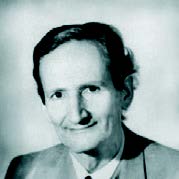A brief biography of
József Hatvany

(1926-1987)
József Hatvany was born on 18 November 1926 in Budapest. He began his studies in Hungary, continued in England from 1938 and graduated as a physicist at Trinity College, Cambridge. He returned home in 1947. He first worked for the Free Trade Union of Hungarian Engineers and Technicians, and from 1948, he was a lecturer at the department of László Rudas at the Karl Marx University of Economic Sciences. From 1950, he was the head of the secretariat of the Central Office of the MTA (Hungarian Academy of Sciences). In 1952, he was arrested and convicted on trumped-up charges. He was released from prison in 1956.
From 1956 he was a staff member of the Cybernetics Research Group of the Hungarian Academy of Sciences. From 1960, he worked at the Central Research Laboratory of Metrology, and from 1965 until his death, he worked at the Institute for Computer Science and Control of the Hungarian Academy of Sciences (MTA-SZTAKI).
During the last years of his prison term, he designed digital automatics and machines in the office No. 401 of the Directorate of Public Interest Works. Some of his inventions were even patented. In the Cybernetics Research Group he contributed to the creation of the first Hungarian computer. As a staff member of the MTA-SZTAKI, his interests were focused on computer-aided design and manufacturing, as well as integrated systems for production management. His name is associated with the development of some devices and equipment which were of strategic importance for a long time in the era of opposing world systems and were on the embargo list (e.g. graphic display, multi-dimensional machine tool control for the automatic design of complex surfaces). He achieved the first domestic directly computer-controlled distributed machine tool control and the introduction of flexible manufacturing systems in factories. His publications exploring the application of artificial intelligence methods in engineering design and manufacturing have also generated significant international resonance, highlighting some effective principles and methods for overcoming knowledge gaps.
He obtained his candidate of sciences in engineering in the late 1960s. In recognition of his work, he has been elected to membership in the US National Academy of Engineering (1985), the International Institution for Production Research (CIRP, 1984), the Society for Information Display (SID, 1971) and the International Federation for Information Processing (IFIP, 1973), where he held various positions.
He has been a member of the Systems Engineering Committee of the Section of Engineering Sciences at the Hungarian Academy of Sciences, an officer of the MTESZ Scientific Society of Mechanical Engineering (GTE) and the Scientific Society of Metrology and Automation Science (MATE).
From 1975, he was a professor at the Budapest University of Technology. In 1985, he was awarded an honorary doctorate by the National Polytechnic Institute of Toulouse (Institut National Politechnique de Toulouse).
He has been a member of the editorial boards of several foreign journals (e.g. Computer Aided Design, International Journal of Man-Machine Studies, Computers and Graphics, Computers in Industry, Robotics and Computer-Integrated Manufacturing).
He has published more than 170 papers, two of which have attracted considerable interest worldwide (World Survey of Computer-aided Design, Computer Aided Design, 1977. No.2., pp. 79-98. [co-authors: Newman, W. M. and Sabin, M. A.] and Computer-aided Manufacturing: an International Comparison, Washington, National Academy Press, 1981., 71p. [co-authors: Yoshikawa, H. and Rathmill, K.].
He has published more than 170 papers, two of which have attracted considerable interest worldwide (World Survey of Computer-aided Design, Computer Aided Design, 1977. No.2., pp. 79-98. [co-authors: Newman, W. M. and Sabin, M. A.] and Computer-aided Manufacturing: an International Comparison, Washington, National Academy Press, 1981., 71p. [co-authors: Yoshikawa, H. and Rathmill, K.].
In the 1970s and 1980s, Professor József Hatvany was a world-renowned expert in applied informatics, including computer-integrated manufacturing, and in the tense political situation of the time he did a great deal to ensure that outstanding Hungarian researchers in this field had access to international forums and contacts in the most advanced Western countries. He personally launched many young researchers on the road to international success. His diligence, his legendary command of English, his insight and his outstanding role in the education of young scientists all contributed to the fact that the Hatvany School was already talked about in his workplace, MTA-SZTAKI, during his lifetime. Thanks to his professional links with SZTAKI, which go back several decades and are still alive today, many specialists at the Budapest University of Technology and the University of Miskolc have declared themselves (and still do) to be Hatvany students.
The respect for the memory of József Hatvany and the love of his former students led to the proposal to establish the József Hatvany Doctoral School for Computer Science and Engineering at the Faculty of Mechanical Engineering of the University of Miskolc.


